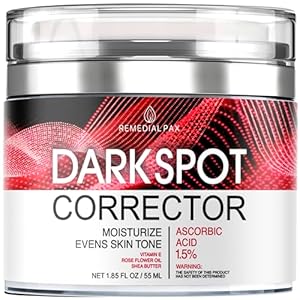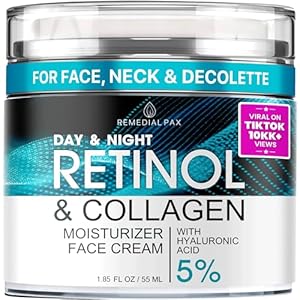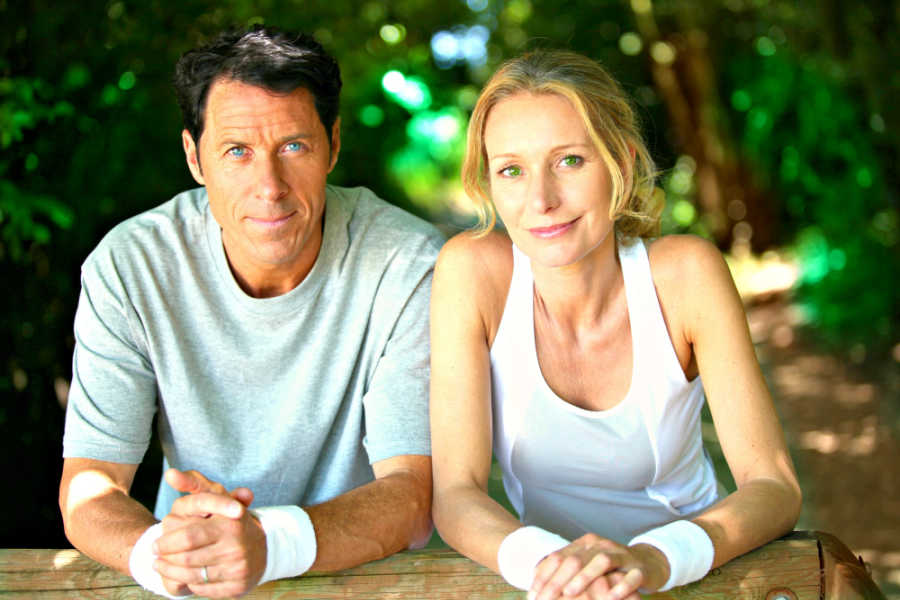
Rosacea & The Baby Boom Generation: Potential Causes and Solutions
If you’re over 50 and constantly dealing with a flushed face, you might be thinking, “What’s happening to my skin?” It’s frustrating when redness won’t fade, and it’s not just aging—it could be rosacea.
You’ve tried everything, but the redness, dryness, and flare-ups persist, leaving you feeling self-conscious and stuck.

Flushed face
and other symptoms like dryness, swelling, and a stinging sensation can make
dealing with rosacea frustrating. Especially since most advice focuses on younger
people with rosacea, often overlooking older individuals.
If you’re dealing
with these issues, understanding that your skin needs special care can make a
big difference.
Here are a few tips to manage rosacea:
- Use
sunscreens with high SPF. - Wear
protective clothing in extreme weather. - Follow
a gentle
skincare routine.
The good news? You don’t have to let rosacea win. With a few tweaks you can start managing it. Let me help you feel confident in your skin again. Ready? Let’s dive in!
Rosacea often hits between 50-65, bringing more than just redness—stinging, flakiness, and frustration when most advice seems aimed at younger skin. But your skin has different needs now, and that’s okay.
The good news? You don’t have to let rosacea win. With a few tweaks—like the right sunscreen and gentle skincare—you can start managing it. Let me help you feel confident in your skin again. Keep reading to learn how…
What is Rosacea
Rosacea is a persistent
skin condition that often shows as redness and a flushed appearance on your
face. You might notice red bumps and cysts primarily on your face and chest.
Sometimes, rosacea can cause a burning or stinging feeling on your skin.
Demographic Profile
Common For Both Men & Women Of European Ancestry
Rosacea is most common for those with European (particularly Celtic) ancestry4. However, it can also develop for people of other backgrounds. While it can occur for both sexes, it’s somewhat more prevalent amongst women5.
Women typically develop rosacea around the cheek and chin area. Men, on the other hand, experience rosacea around the nose far more frequently than women. Rhinophyma (a form of stage three rosacea skin disorder – the most severe) is almost exclusively an elderly male phenomenon1.
Rosacea skin disorder – frequency among baby boomers
It’s possible for rosacea to manifest at any age but it usually begins mid-adulthood. The age profile of rosacea1 is different for women than it is for men.
Rosacea becomes more common after the age of 35 for women, while the increase in prevalence happens later for men (after 50). The frequency of rosacea in the population also peaks later for men (around 76-80 years) than it does for women (approximately 61-65).
Rosacea is especially troubling for the elderly generation. It typically doesn’t go away by itself – and rosacea can get worse and worse without medical intervention6. Ignoring the problem for years results in a more severe form of rosacea as you get older (with increasingly intense symptoms).
age group commonly affected
Areas and Key Points:
- 30s-40s: Cheeks, nose, chin. Initial flare-ups
- 50s-60s: Forehead, more permanent redness. Tiny blood vessels visible
- Elderly Men
Nose (rhinophyma)
Most severe stage
Remember, rosacea isn’t just about redness; it can have real
emotional and physical impacts. Understanding the age and gender dynamics can
help you better recognize and manage the symptoms.
rosacea skin disorder: frequency Among baby boomers
Rosacea often appears in mid-adulthood and tends to affect
people differently based on gender. For women, rosacea commonly starts after
age 35. For men, it usually begins after age 50. You’ll find that for men, the
most frequent cases occur between ages 76 and 80, while for women, it peaks
around 61 to 65.
If you’re a baby boomer dealing with rosacea, you’re not
alone. This condition is particularly challenging for older
adults, as it tends to get worse over time without treatment. It’s not
unusual for rosacea to affect not just your face but also your neck,
chest, and even scalp.
Don’t ignore your symptoms! Ignoring it often leads to more
intense symptoms and make it harder to manage. Taking early steps to treat
rosacea can significantly improve your quality of life. If you notice your symptoms getting worse, see a dermatologist ASAP!
For more detailed information, you can visit Mayo Clinic’s guide
on rosacea.
Causes and aggravators
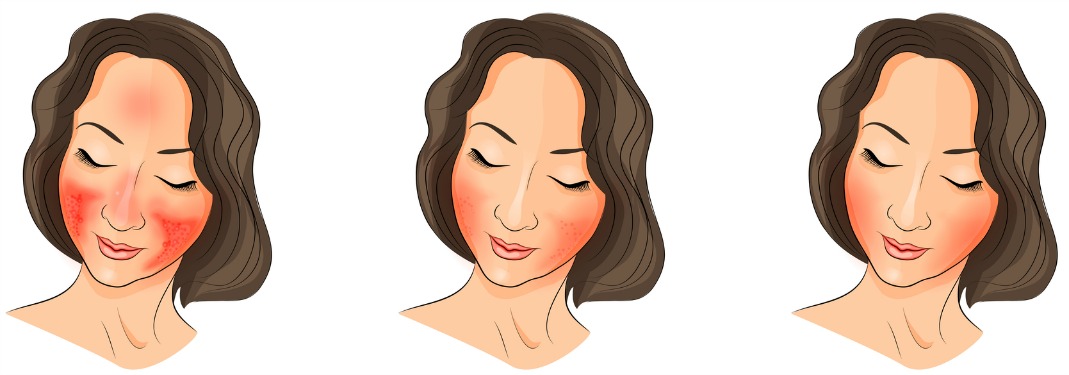
Scientists are uncertain about the exact cause(s) of rosacea. However, a number of potential causes, contributory factors, and aggravators have been identified.
Potential Causes
– Family History
One 2015 study7 concluded that rosacea is driven by approximately 50% genetic and 50% environmental factors. A 2010 study8 revealed rosacea sufferers are more likely to have photosensitive skin, have a family history of rosacea, and to have smoked cigarettes in the past.
Despite common misconceptions, rosacea sufferers were no more likely than non-sufferers to drink more caffeine or alcohol. Further research reaffirms this finding – rosacea is not causally connected to caffeine or alcohol consumption1,9.
– Hormones
This condition is sometimes linked to hormonal changes as a woman enters the menopause phase of her life. When you’re going through menopause the added stress of rosacea is the last thing you nee
– Immune System
Evidence from a 2011 analysis10 suggests rosacea is caused by an excessive innate immune system response. An overactive innate immune system results in the production of abnormal peptides. Lab tests reveal that these abnormal peptides produce rosacea-like skin inflammation. The authors of this study suggest that this overactive innate immune system response may have a genetic basis.
– Mites
It’s possible that Demodex mites (oil mites) cause rosacea11. These mites live on all humans – especially in the hair follicles and the sebaceous glands on the face. Sufferers of rosacea have higher amounts of oil mites on their skin than the general population.
However, it’s not clear whether the over proliferation of these mites cause or are caused by rosacea. It could be the case that rosacea spawns from an overabundance of mites emerging on damaged skin due to weather11, aging, or overproduction of sebum.
– Drugs
Some drugs can potentially induce rosacea or make an existing rosacea case worse – particularly topical or systemic corticosteroids12.
Known irritants
While the exact causes of rosacea are still disputed and somewhat unclear, it’s understood certain triggers can exasperate this condition, such as food and nutrients.
As our population continues to age, we need to do more to address these skin issues for the 65+ age cohort.
Helpful Rosacea Product Tips
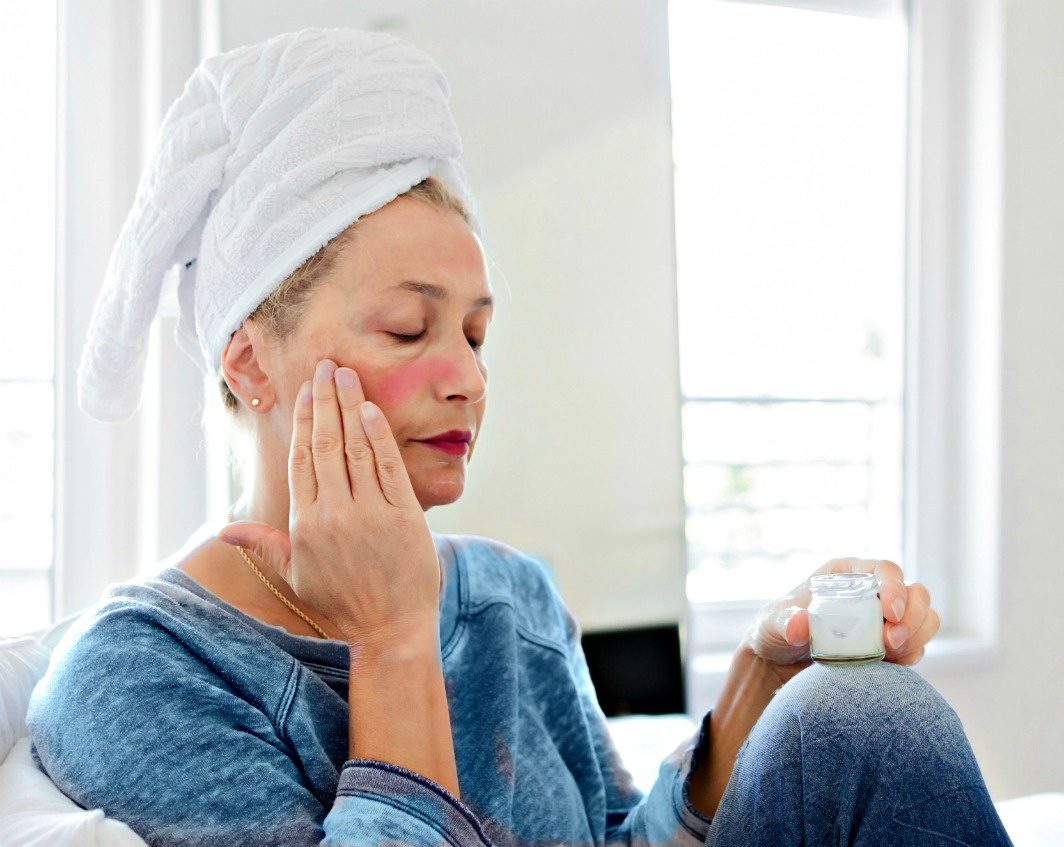
Repeated inflammation from rosacea can harm your skin and weaken collagen and elastin, making it age faster. Using rosacea-friendly cosmetics is crucial to soothe irritation and protect against collagen damage, preventing thin, sagging skin and wrinkles.
Note:
Studies Need to Include Senior Citizens!
Many basic or essential skincare products can cause rosacea flare-ups1, especially in individuals over 65.
Sadly, clinical trials for skincare products often overlook this age group, since the elderly aren’t typically the primary focus of new skincare products.13 😒
However, it can be argued that testing on aging skin is crucial, given the increased need for it.
Flushed Face: 4 Essential Products to Consider
Cleanse
Look for cleansers that are pH balanced and don’t contain sodium lauryl sulfate (which can irritate.) Cleansers like Cetaphil or Cerave work without drying or irritating. My husband has rosacea and has great results using the Walgreens brand, which is cheaper.
Exfoliate
This is very important! Gently exfoliating rosacea skin not only helps smooth your complexion, unclog pores and reduce flaky patches, but prevents the disease from worsening.
Skin thickening in rosacea worsens the condition by increasing redness, reducing treatment effectiveness, and causing more severe symptoms like rhinophyma, which is an enlarged, bumpy appearance on the nose. It’s important to use exfoliating products specifically for rosacea.
Hydrate
Sometimes, regular moisturizer just don’t cut it for this condition. Good hydration supports collagen, making pores look smaller, and makes broken blood vessels less noticeable.
My husband has rosacea and tells me this super moisturizer with recovery cream with omega 3 rich fatty acids and ceramides keeps his face comfortable and smooth.
Sunscreen
The same goes for sunscreen. You need to use one that’s formulated for your condition. Here is another of my husband’s favorite rosacea sunscreen. He likes this because, unlike regular sunscreens, this is the only one that won’t make his face breakout.
Related Content: Is Slugging a Good Idea for Rosacea Suffers?
Solutions
Rosacea is not easy to completely cure. Not too surprising, given that it’s potentially the result of an abnormality16 in our innate defense system!
Thankfully, there are multiple treatment options available to reduce the symptoms of rosacea. Treatments are increasing and becoming more safe over time.
So if you suffer from just the occasional flushed face or all the rosacea symptoms listed here, it’s important to consult your doctor to find the best treatment for your particular situation.
Treatment will vary from case to case depending on the severity and longevity of the rosacea, while also taking any potential comorbidities into account (rosacea is commonly comorbid with depression17).
Current treatments include:
- Topical creams (azelaic acid or metronidazole gel) help repair the barrier of rosacea-induced broken skin. A recent 2018 study revealed oxymetazoline cream (Rhofade) helps reduce facial flushing and redness for rosacea patients18. However, because rosacea damages the barrier of the skin, these creams can often cause a burning or stinging sensation.
- Surgery (including laser surgery) is useful to treat rhinophyma1 and the prominent erythema common in older rosacea patients.
- Hormone replacement therapy can help treat rosacea-like menopausal flushing19.
- Beta blockers (like propranolol) work to reduce the severity of anxiety-related rosacea20.
- Acupuncture is a potential rosacea treatment. A 2018 case study21 revealed acupuncture was more effective at improving the rosacea of one 52 year old woman than conventional treatments. However, more research with much larger sample sizes is needed to determine its efficacy.
In addition to the treatments above, try to avoid aggravating the rosacea by taking these steps:
- Use UVB and UVA sunscreen protection daily.
- Protect your skin from harsh weather conditions by wrapping up warm and keeping your skin moisturized in cold or windy weather.
- Keep your stress levels low by taking time out of your day to relax.
- Steer clear of skincare with irritating ingredients like alcohol and fragrance.
Consult your doctor for a diagnosis
Rosacea can negatively impact an individual’s quality of life and there’s a certain stigma attached because it’s often misunderstood as a symptom of alcoholism.
Rosacea typically develops gradually over time. Symptoms like a flushed face may come and go but this skin condition usually doesn’t disappear by itself.
It’s important to treat the condition, otherwise it’s possible rosacea can accelerate into disfigurement22 or loss of vision (in the case of ocular rosacea).
It’s often (understandably) confused with acne as the symptoms can be similar. Yes, you’re never too old to suffer from acne or clogged pores and blackheads.
Elderly rosacea patients sometimes mistake the symptoms as just a normal part of the aging process22. That’s why it’s always important to consult your doctor for a proper diagnosis.
ABOUT
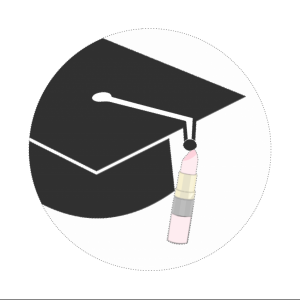
Author bio:
Laura shares beauty tips & tricks, reviews products, and evaluates academic research related to makeup at Makeupscholar.com.
References:
1.https://www.sciencedirect.com/science/article/pii/S0738081X10001240
3. https://www.ncbi.nlm.nih.gov/pubmed/27323701
4. https://www.ncbi.nlm.nih.gov/pubmed/19735524
5. https://ghr.nlm.nih.gov/condition/rosacea#statistics
7. https://www.ncbi.nlm.nih.gov/pubmed/26307938
8. https://www.ncbi.nlm.nih.gov/pubmed/19874433
9. https://www.ncbi.nlm.nih.gov/pubmed/30347034
10. https://www.ncbi.nlm.nih.gov/pubmed/22076322
11. https://www.ncbi.nlm.nih.gov/pubmed/22933353
12. https://www.ncbi.nlm.nih.gov/pubmed/16384751
13. https://www.ncbi.nlm.nih.gov/pubmed/20367673
14. https://www.ncbi.nlm.nih.gov/pmc/articles/PMC3840548/
15.https://academic.oup.com/gerontologist/article/56/Suppl_2/S230/2605262
17. https://onlinelibrary.wiley.com/doi/abs/10.1111/j.1365-2133.2005.06895.x
18. https://europepmc.org/abstract/med/29320594
19. https://www.ncbi.nlm.nih.gov/pubmed/28807107
20. https://www.ncbi.nlm.nih.gov/pubmed/16243148
21. https://www.ncbi.nlm.nih.gov/pubmed/30142810
22. https://www.ncbi.nlm.nih.gov/pubmed/12038728
before you go…
If you enjoyed this content, show some love by tapping the 💙 in the bottom right corner (you’ll find it on almost every page). It lets me know you found it helpful and fun. Thanks a bunch!
Trending Products

